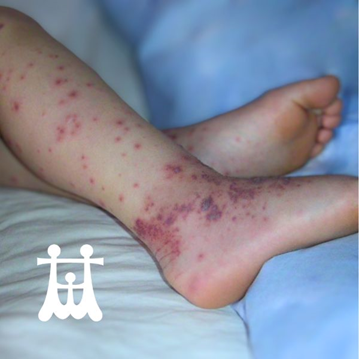Dr Mattias Larsson*
Ngọc is an energetic five-year-old boy, usually constantly roaming around and playing. One day the parents noticed that he was limping and took him to the local clinic where they examined him and diagnosed a leg infection. Ngọc received some antibiotics and the parents were told that it would improve after a few days.
However, after three days Ngọc's condition deteriorated. He became unable to bear weight on his right leg, resulting in a noticeable limp. In addition, he expressed discomfort in his joints, knees, ankles and stomach. Concerningly, when he used the restroom, his parents discovered the presence of blood, along with diarrhoea and pink-coloured urine. This made them even more worried. They had heard that Family Medical Practice had good pediatric care and decided to bring him there.
When meeting the pediatrician, the parents were asked about earlier disease or trauma. The parents had not noticed anything, Ngọc said that a friend pushed him at kindergarten. The parents also remembered that he had a cold and fever two weeks ago. During examination, the doctor found swollen ankles and hands with local tenderness and a skin rash, which looked like small bruises or small reddish-purple spots on the bottom of the legs and around the elbows and the scrotum was also swollen.

The cause of Henoch-Schönlein Purpura is unknown, but it is commonly triggered by a viral infection. Photo courtesy of Mattias Larsson
The results of the blood test indicated that the CRP (C-reactive protein) levels were within the normal range. However, the CBC (complete blood count) revealed a slight elevation in white blood cell count and a slightly low platelet count, suggesting the presence of inflammation. The urine dipstick test showed the presence of red blood cells. Furthermore, the abdominal ultrasound revealed thickening of the intestinal wall. Fortunately, the X-ray did not reveal any fractures.
The pediatrician explained that Ngọc was suffering from Henoch-Schönlein purpura, which is a condition where small blood vessels in the skin become inflamed (irritated and swollen), causing a rash that is called purpura. The blood in the stool and urine as well as swelling of kidneys is caused by the blood vessels in the bowel and the kidneys becoming inflamed. The type of kidney damage present is glomerulonephritis, which refers to the injury affecting the filtering component of the kidneys known as the glomerulus. In rare cases it might also lead to complications in the lungs, brain or intussusception (abnormal folding of the intestinalis), but Ngọc had no signs of that. The diarrhoea was most likely due to the antibiotics prescribed in the local clinic and not related to Henoch-Schönlein purpura.
The cause of Henoch-Schönlein purpura is unknown, but it is commonly triggered by a viral infection. The symptoms can take days to weeks to fully develop, so it is likely to relate to the fever and cold symptoms Ngọc had two weeks earlier. It is most common among children aged from two to ten years of age, but it may happen in anyone. Henoch-Schönlein purpura is not contagious, however, it is important to note that the infection responsible for triggering it may be contagious.
Ngọc received a drug called prednisolone to decrease inflammation, kidney, stomach and joints as well paracetamol for the pain. He also received Angiotensin Converting Enzyme inhibitor (ACEi), and Angiotensin II receptor blocker (ARB) to reduce the protein levels in his urine in order to minimise the likelihood of developing glomerulosclerosis, which is the scarring of the glomeruli (small structures that form part of the kidney’s filtration system). For the diarrhoea he received oral rehydration and probiotics.
The pediatrician also explained that long-term follow-up is very important. Six months later Ngọc was given a urine test and a blood pressure check, at that time he had no symptoms and when he went for a final check at 12 months he was fully recovered. Family Medical Practice
*Dr Mattias Larsson is a pediatric doctor at Family Medical Practice and associate professor at Karolinska Institutet and has a long experience in research on infectious diseases. He has worked with the Oxford University Clinical Research Unit and the Ministry of Health of Việt Nam. He is fluent in English, Swedish, Vietnamese, German and some Spanish.
Visit Family Medical Practice Hanoi 24/7 at 298I Kim Mã Street, Kim Mã Ward, Ba Đình District.
To book an appointment, please call us at (024).3843.0784 or via Whatsapp, Viber or Zalo on +84.944.43.1919 or email hanoi@vietnammedicalpractice.com.
FMP’s downtown location in Hồ Chí Minh City is in Diamond Plaza, 34 Lê Duẩn Street, Bến Nghé Ward, District 1, and 95 Thảo Điền Street, District 2, HCM City. Tel. (028) 3822 7848 or email hcmc@vietnammedicalpractice.com.
OVietnam